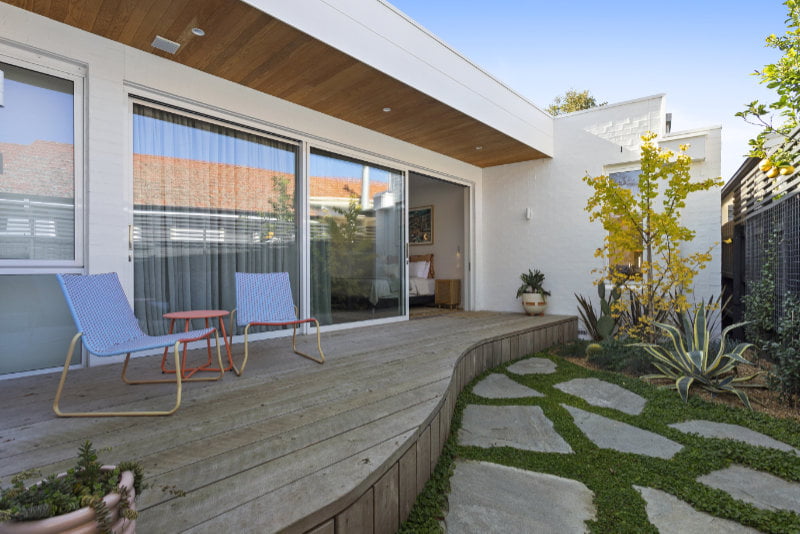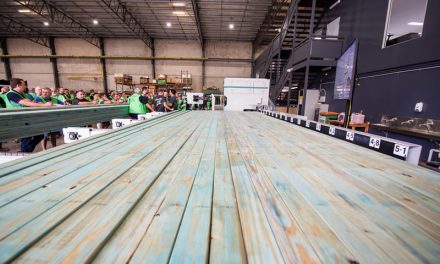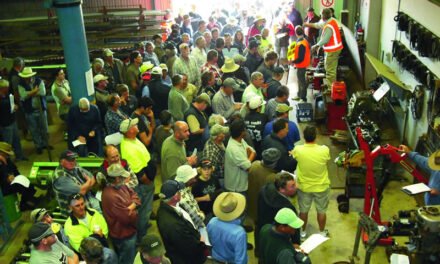Treatment is an invaluable partner in prolonging the life of structural, outdoor and cladding timbers. But many are still unclear on its benefits – and its limits. By Donyale Harrison
By any metric, it’s been a hard year for the standard housing frame. Soaking weather across much of Australia and supply difficulties have combined to leave any number of partly built homes waiting for weeks or even months for roofs and walls.
“We’ve seen a lot of mould on building frames this year,” says Craig Kay, national product engineer at Tilling.
He hastens to add that this isn’t an issue with the treatment: framing timbers are almost always designed to be protected from the weather and contain H2 preservatives, intended to prevent borer and termite attack.
In the big wet, says Kay, “There have been a lot of mould issues on frames made of all sorts of materials, plus other problems we don’t normally get. In a building frame, you tend to treat against insect attack, not against mould, because these timbers are meant to be protected inside, above ground.”
It’s a neat encapsulation of the problems for treated timber suppliers. The timber can be performing exactly for what it was designed to do, but if circumstances change, or it’s used in the wrong application or not maintained appropriately, it can still have issues.
Australia is lucky when it comes to timber treatment. A comprehensive but practical regulatory framework is paired with a large amount of industry expertise and an active industry organisation – the Timber Preservers Association of Australia (TPAA) – that keeps regularly updated information available to all parts of the industry and public.
Alas, as in so many cases, things often fall down in practice. “Wood is a natural product and it has to be treated with a bit of respect,” says Kay. “If you want it to behave in the way you expect it to, then you can’t leave packs of timber out in the rain for months. You’ll need to get a roof on your frame next week, not in the next three months. That sounds like I’m being critical of builders, but of course most of them don’t want to be doing the wrong thing, they just can’t get trades, or they’re under too much time pressure.”
For F&T fabricators, it’s a particularly notable issue. “Because some of their jobs are being held up; they’ve already made those frames and trusses and most don’t have enough under cover storage for multiple jobs, so the wood might be outside for months. The preservation is still there and does its job. But it doesn’t mean the timber is bulletproof.”
EDUCATING THE MARKET
Koppers Performance Chemicals is a leading supplier of timber preservative chemicals. In addition to supplying a wide range of treatment options to timber treaters, the company invests heavily in R&D and works closely with customers to keep them abreast of advances in technology and changes in standards and regulations (often acting as a key industry voice in the latter).
Education and information sharing are a large part of what the team at Koppers do. “We’re happy to provide appropriate training to all different levels along the supply chain,” says Elias Akle, general manager. “It’s to our benefit, and to our customers’ benefit. Almost all of the failures that occur happen because the product isn’t appropriate for the application or it’s not being used properly. You don’t use LOSP-treated timber in ground. You don’t use H2F blue timber in your decking structure outside, or H3 treated timber in ground-contact applications. When wood is used as recommended, the preservatives work.”
One of the most common causes of failure Akle hears about is due to treated timber used outdoors being cut and then not resealed correctly. “This happens in H3 or H4 applications, especially products like sleepers,” he says. “Cutting timber, even partially, may expose some untreated heartwood, which can then make those untreated areas vulnerable to decay. We recommend that any treated timber product used in outdoor applications be resealed with a recommended product such as CN Timber Oil or XJ Clear Timber Protective if cut. Coating the end with a paint is not sufficient.
“These problems tend to occur at a retail level, which is a step or two’s remove from us. Better education of sales staff will help, and we’d also recommend stocking resealing products in the timber section of the retail store rather than in the paint/coating section.”
As to which treatments he recommends, “We provide choice,” says Akle. “There are markets in which it’s appropriate to be using CCA, or MicroPro, or LOSP or ACQ. In terms of our product development, we try to respond to what we see happening in the market.
“We do, though, advise our customers who currently only treat with CCA that they should consider building in capacity for an alternative preservative such as MicroPro, so their customers are aware that they have options.”
This isn’t a reflection on CCA, which has been used safely in Australia for over 50 years, but an acknowledgement that the regulatory environment and market perception around treated timber has shifted in recent years. In addition to the wider range of applications in which copper-based treatments are approved, end of life disposal can be easier. For example, since early 2020 Queensland has allowed ACQ-treated timber shavings to be used as a resource in compost or mulch, which can be more economical than the disposal methods other treated timbers are consigned to.
“Increasingly we are seeing consumers and specifiers seek out products which have a better OH&S and environmental profile, Akle adds. “There are concerns around the exposure to chemicals by workers at treatment plants. Safe Work Australia is reviewing the Worker Exposure Standards for airborne contaminants. Wood dust is a part of this review as are some of the components of the CCA timber preservative. The outcome of this review and subsequent legislative action may make using some products such as CCA more difficult for some treatment plant operations.
“Aside from this regulatory review, we’re sensing a growing interest in products that are perceived to offer a better safety profile and, importantly, are deemed more sustainable. There is genuine concern in some sectors around the disposal of treated wood at the end of life. Koppers is working on a number of projects, including industry-based ones looking at the circular economy and how we make treated wood products more sustainable.”
Disposal of treated products continues to be a central issue for the timber industry however change is slow. “We believe that the disposal of treated wood, especially CCA-treated wood, will continue to become more difficult and expensive,” says Akle. “The industry needs to develop alternate pathways for treated wood at the end of its life rather than simply using landfill. There is a lot of work to do in this area. Koppers will be working with FWPA and The Centre for Timber Durability and Design Life on a project focused on the reuse/recycling of treated timber.
“Both in Australia and globally, Koppers is doing a lot of work around the recovery of treated wood products, especially when it comes to the power poles and railway sleepers it produces and sells. Any outcomes from these initiatives will be made available to the wider timber preservative industry. It will take time but our commitment to this goal is very strong and a central part of our sustainability strategy.”
One wider regulatory shift has been the 2021 update to the Australian Timber Preservation Standards AS/NZS 1604 series. “We’ve worked with our customers to review the new standards and explain to them what the changes are and how they relate to their businesses,” Akle says. “The treating requirements (penetration and retention) in the standard remain relatively unchanged. It’s the verification aspects that have changed and these are what we’ve spent the most time working on with our customers.
“We’ve already noticed that many of our customers have a better understanding of the new requirements and, working with us, they’re introducing systems to monitor and verify that they are indeed meeting the requirements of the standard. This work is ongoing but we believe the quality of treated timber products will improve even more over time as treatment companies set up quality control systems and procedures.”
BUILDING RIGHT
The major timber preservation chemical suppliers in Australia all supply a high level of product and information to their customers. Koppers, Arxada and more have teams who will work closely with their customers to help them select the best treatments for their timber products. The new standard adds assurance that those customers are delivering a high-quality treated product.
And yet Kay at Tilling still takes calls from agencies like the QBCC investigating why a treated timber has failed.
“We’ll have someone ring up and ask, ‘What did you have in your design guide back in 2007 for decks?’,” says Kay. “We’ll show them what we had and the investigator will sigh, ‘Oh. They haven’t followed it.’
“The devil is in the detailing,” Kay insists. “If you don’t get the detailing right, it doesn’t matter how well the timber is treated, it’s not going to perform well. If your timber is detailed properly, it will perform as required.”
The onus is on the designer to be realistic about the conditions the timber will be exposed to and the expectations on that timber. And while recent rains and floods prove that not everything can be predicted, most of the problems arise from expectations that were always unreasonable.
“The thing about treated timber is that, especially in the H3 environment, it’s not bulletproof,” says Kay. “People have to be careful in using the right treated timber where it’s seen visually, because some species check and crack more than others when they’re exposed.”
While treatment hazard classes (H1–H6) describe the level of treatment or level of protection that must be applied to the wood, different timber species treated to the same hazard class will still retain the natural characteristics of each species (strength, stiffness, hardness, abrasion resistance, etc.), meaning that, most of the time, selection or substitution requires much more than simply looking for a timber with a particular treatment level.
Add to that some of the less-common treatments on the market, such as thermal modification and resin impregnation, which do affect some characteristics and the situation becomes even less straightforward.
“If it’s an inappropriate choice or the wrong position, as the moisture rises and falls and the sun gets on it, it will crack and it will check,” Kay says.
“Usually, it hasn’t failed, it just looks weathered. The preservative is still working, and the timber is still doing its job, but you might not have the look you want anymore. You’ll need a different timber, or a less exposed position.”
Unfortunately, a combination of time-poor builders and clients who are pushing for completion (often in the face of rising costs) means that mistakes can still be made. Couple this with a loss of timber expertise within parts of the construction industry and the timber suppliers and design/engineering teams can be left to do a lot of the heavy lifting when it comes to determining suitability – and they’re frequently not in a position to insist that advice is adhered to.
“The good news,” says Kay, “is that we’ve got a lot of things pretty much right with the National Construction Code and the standard. We need to make sure our product meets the requirements for durability, which guides what we treat and how we treat it, so we supply what the market wants.
“We do have some products that treat more easily than others. And so we’ve had to develop new ways of treating some of the harder-to-treat species, which has been a challenge for the industry. But if something is treated properly, in its right occasion, it appears to be working quite well.”
Tilling’s treatment range includes a range of different chemicals and processes. “We do some LOSP, but the trend is more to water-based,” Kay says. “So you’re not exposing your staff and others to solvents, and you haven’t got solvents flashing off into the atmosphere. Most of our H3 treatment is water-based azoles, for example.
“And the other advantage of that is that all our solvents are imported, so add the cost of shipping, and the price of petroleum has gone shooting right up. The cost of water, on the other hand, is fairly stable. It’s about the only thing we’ve got a lot of at the moment.”
STRONG PARTNERS
Daniel Wright, national business development manager at Australian Sustainable Hardwoods (ASH), points out that while preservation treatment is important, it’s just one part of a broader system around durability.
“Our treatment partners do a superb job, but that’s not the end point,” Wright says. “When you’re looking at a 25- or 50-year design life, more is needed. That might be capping the fully exposed elements. It’s almost always maintaining the coating and the efficacy of the coating – which falls on the client for upkeep. But also, it’s taking care with the connection and design and detailing and making sure everything is done properly.
“If some of these steps are omitted, then weathering can start to degrade the timber and that can speed up the ageing process. For structural timber, that’s obviously a concern, but the visual impacts will show up faster and for architectural designs that rely on a lot of visually expressed timber, that will impact the final building and can impact that client’s willingness to use timber on their future projects.”
Accordingly, Wright works to assist and educate the company’s clients, to help them get the best out of ASH’s hardwood and mass timber products.
ASH has long partnered with Fisher’s Timber Treatment and commissions a range of mostly H3 and H2 treatments on their cladding and structural F17 products. They’ve treated a handful of orders of H3 MASSLAM (ASH’s mass timber systems), which requires the clients flash or clad members to conform with Service Class 2.
Fisher’s uses Tru-Core Wood For Life from Kop-Coat, which combines vacuum impregnation with a non-volatile carrier. This sees the treatment (mostly permethrin, azole or a combination) penetrate deep into the core of the timber, while maintaining the wood product’s natural appearance, dimensional stability and mechanical properties – characteristics that are particularly important for structural and engineered timbers.
“For our normal section sizes, we get full penetration in hardwood, which is really unusual,” says Wright. “That means you can cut, drill, dock, mortice or flute the timber without affecting the warranty. All the things you’d expect to do for a cladding or a batten aren’t going to impact it.”
There are limitations, of course. For the special-order H3 treated Masslam, ASH CNC the members first, which allows a deep penetration and protection on all the cuts and drillings. For window profiles and similar products, however, it’s more complex again, even with Tru-Core.
“Treatment comes with a warranty,” Wright says. “Timbers don’t come with a warranty. We talk about durability classes 1, 2, 3 and 4, which come with an expectation, but it’s not a guarantee. H3 treatment has a guarantee. And so that really is an extra benefit.
“But if we’re doing, say, a really thick piece of timber with a deep penetrative treatment; if you were to mould that into, say, a window profile after treatment, it voids the warranty, because you’re taking most of the treatment off. There’s still treatment left in that timber, so it’s going to be more durable than the natural timber that we would have sold otherwise, but you need to ask yourself a question if you’re going to mould the timber. What’s your objective? Do you want a 25-year warranty, or do you just want something that’s going to be a bit more durable?”
ASH’s wide range of products means that Fisher’s has had to come up with multiple specific approaches. There is no basic ‘H3 treatment’ out there, but rather an enormous range of options from chemical selection (which may be by the name of the active product, such as copper azoles, or a brand name for the compound) to treatment methods (how the chemicals are taken in by the sapwood, ranging from envelope treatments and brush-on products that form an outer ‘skin’ to pressure and vacuum applications that use the same cellular pathways that once carried the tree’s sap).
Getting these approaches right takes effort, particularly for timbers and products that are new to the market. Some products are more difficult than others, whether that be sawn timbers with a high percentage of heartwood (which treatment chemicals find harder to penetrate) or engineered timbers. With CLT and glulam production on the rise in Australia, the major preservative chemical companies are researching approaches that will make their treatment easier.
Overall, it’s all about having a trusted partner. “We’ve had a long relationship with Fisher’s, going back way before they were using Tru-Core and before my time,” Wright says. “It’s a really good relationship: we’re both in a similar pocket of Gippsland and we have similar approaches, particularly with new products.
“For example, we’re focusing on increasing our mix of timber species. One of our new focuses is American Oak, and it’s not a case of simply using the same H3 treatment we use on other species. There’s a lot of R&D that goes into it. You have to get the mix and the formulation right. And there’s a bit of trial and error, a bit of testing, some back and forth. It really does require a collaborative effort. And they’re brilliant. We’ve dealt with each other a lot, so we both know what to expect and what’s required – and we’re both prepared to do the work.”
As to how others can replicate that success, Wright quips that they should just be buying from ASH. “But if you’re a supplier, I can only advise developing that sort of collaborative relationship with your treatment company, so that you can get that best result for each product.”
For more, visit www.kopperspc.com.au, www.tilling.com.au, www.ash.com.au, www.fisherstimbertreatment.com.au, www.arxadawoodprotection.com/apac/ and www.tpaa.com.au
Image: Timber must be treated and maintained to its conditions: the American Oak cladding here is protected far more than the decking. Courtesy Australian Sustainable Hardwoods












